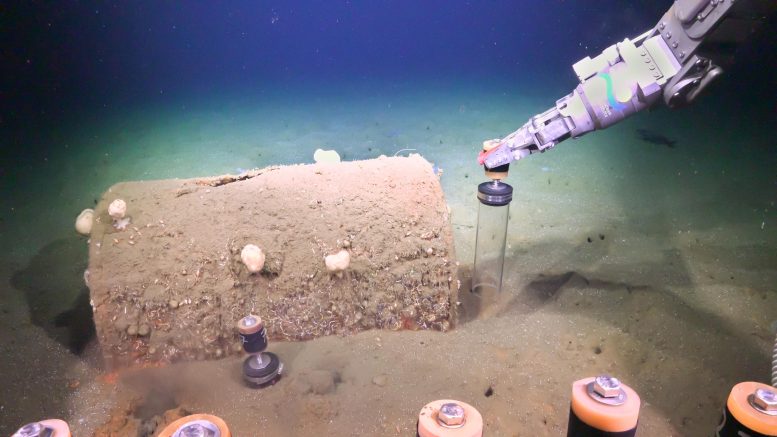
Researchers about Research Vessel Falkor used Remotely Operated Vehicle SuBastian to collect sediment push cores off the coast of Los Angeles during the Biodiverse Borderlands Expedition in July 2021. Credit: Schmidt Ocean Institute
New research shows that deep-sea fish near Catalina Island are contaminated with DDT-related chemicals, revealing ongoing risks from decades-old pollution.
During the mid-20th century, the country’s largest DDT manufacturer used the ocean off the Los Angeles coast as a dumping site. This chemical, harmful to both human health and wildlife, still lingers in the coastal ecosystem over fifty years later. Although legal at the time, when the details of this industrial-scale pollution gained widespread attention in 2020, it raised major concerns from both scientists and the public.
In a new study, researchers from UC San Diego’s Scripps Institution of Oceanography and San Diego State University found that deep-sea fish and sediments collected near the Catalina Island offshore dump site are contaminated with numerous DDT-related chemicals. The study, recently published in the journal Environmental Science and Technology Letters and funded by the National Oceanic and Atmospheric Administration, reveals that the remnants of DDT dumped decades ago may continue to infiltrate the marine food webs.
Impact on Marine Ecosystems and Human Health Risks
Researchers are urgently investigating whether the deeply buried DDT residues are seeping into marine ecosystems and posing risks to wildlife and human health. “These are deep-sea organisms that don’t spend much time at the surface, and they are contaminated with these DDT-related chemicals,” said Lihini Aluwihare, a professor of ocean chemistry at Scripps and co-author of the study. “Establishing the current distribution of DDT contamination in deep-sea food webs lays the groundwork for thinking about whether those contaminants are also moving up through deep-ocean food webs into species that might be consumed by people.”
What Is DDT?
DDT (dichlorodiphenyltrichloroethane) is a synthetic chemical compound known for its insecticidal properties. Developed in the 1940s, DDT was widely used to control malaria and other insect-borne diseases, as well as agricultural pests. Although highly effective, widespread use of DDT led to environmental and health concerns, including its persistence in the environment, accumulation in the food chain, and potential links to cancer and other health problems in humans. These issues prompted a global movement against DDT, culminating in its ban in many countries following the 1972 U.S. ban and its restrictions under the Stockholm Convention on Persistent Organic Pollutants in 2001. However, some countries still use DDT in a controlled manner to combat malaria.
Regulatory Background and Historical Context
From 1948 until at least 1961, barges contracted by DDT-producer Montrose Chemical Corporation would motor from the Port of Los Angeles out toward Catalina and pump manufacturing waste laden with sulfuric acid and up to 2% pure DDT directly into the Pacific Ocean. Legal until 1972, this offshore dumping largely escaped public scrutiny because it was overshadowed by Montrose’s other waste disposal practice: Pumping a more dilute acidic slurry that also contained DDT through L.A. County sewers and into the ocean off Palos Verdes. An estimated 100 tons of DDT ended up in the sediments of the Palos Verdes Shelf, and the Environmental Protection Agency declared it an underwater Superfund Site in 1996. In 2000, a judge ordered the company to pay $140 million to remedy the environmental damages. Research has since linked the DDT pollution on the Palos Verdes Shelf to contamination and health problems in local wildlife including sea lions, dolphins, bottom-feeding fish, and even coastal California condors (likely from consuming dead marine mammals).
Rediscovery and Public Awareness
The Catalina dumpsite, now known as Dumpsite 2, was rediscovered in 2011 by David Valentine of UC Santa Barbara using an undersea robot. The findings gained public attention in 2020 when the Los Angeles Times published a series of exposés on the region’s toxic legacy of offshore dumping. Valentine and Scripps researchers have helped map the extent of the dumping, finding DDT-related chemicals across an area of the seafloor larger than the city of San Francisco. What’s still unknown is if that pollution is staying put or if it is moving through the undersea environment in ways that pose dangers to marine life or humans.
Identifying Contaminants
In 2021, Aluwihare and other collaborators began a series of research efforts to work on two key questions: Are the DDT-related chemicals lurking on the seafloor near Dumpsite 2 being stirred up and ingested by marine life in the deep? And could they identify a kind of chemical fingerprint unique to the contamination from Dumpsite 2 and other offshore dump sites that could be used to distinguish them from pollutants emanating from the Palos Verdes Shelf?
The team collected sediment samples and deep-sea animals from the water column in the San Pedro Basin near Dumpsite 2 to test for a wide range of DDT-related compounds. The research cruises to collect these samples were funded by the National Science Foundation and the Schmidt Ocean Institute.
Testing and Results
Typically, testing for DDT looks for four to eight chemicals, but a 2016 paper co-authored by Hoh and Aluwihare identified 45 DDT-related chemicals in the blubber of dolphins from off the coast of Southern California. The results demonstrated that wildlife was being exposed to a much larger suite of DDT compounds in the real world. In the present study, the team tested for this larger suite of DDT-related chemicals, known as DDT+, in hopes that it could help develop a chemical fingerprint for Dumpsite 2 and the other offshore dump sites used by Montrose. Testing for DDT+ also provides a holistic picture of the degree of contamination in sediment and animals that might otherwise go undetected.
When the researchers analyzed the sediments for the presence of DDT+ they found at least 15 chemicals, 14 of which had been previously detected in birds and marine mammals in Southern California.
The researchers collected 215 fish spanning three common species near Dumpsite 2. Chemical analysis revealed that the fish contained 10 DDT-related compounds, all of which were also present in the sediment samples.
Two of the fish species were collected between 546 meters (1,791 feet) and 784 meters (2,572 feet) – Cyclothone acclinidens and Melanostigma pammelas. The third, Leuroglossus stilbius, was collected between 546 meters (1,791 feet) and the surface. The species collected at shallower depths contained a lower concentration of contaminants and were missing a pair of DDT-related compounds that were present in the deepest fishes.
“None of these fish species are known to feed in the sediment of the seafloor,” said Anela Choy, a biological oceanographer at Scripps and co-author of the study. “There must be another mechanism that is exposing them to these contaminants. One possibility is that there are physical or biological processes resuspending sediments around Dumpsite 2 and allowing these contaminants to enter deeper water food webs.”
Ongoing Research and Future Steps
The findings can’t rule out the Palos Verdes Superfund Site as a potential source of the contamination in the fish, said Aluwihare. But several lines of evidence uncovered in the study – the lower overall concentrations and two missing DDT-related compounds in the shallower water fish species, as well as the overlap between contaminants found in the sediment and those found in marine mammals and birds – point to the alarming possibility that pollution is moving from the seafloor and into the marine food web.
“Regardless of the source, this is evidence that DDT compounds are making their way into the deep ocean food web,” said Margaret Stack, an environmental chemist at SDSU and the study’s lead author. “That is cause for concern because it’s not a big leap for it to end up in marine mammals or even humans.”
Hoh said understanding the pathways by which the DDT-related chemicals are entering the food web is vital and “will help us figure out what to do as far as mitigation and what not to do in terms of offshore development that could make this problem worse by stirring up these contaminants.”
Aluwihare said more work needs to be done to pinpoint the source of the DDT contaminants they found in the deep-sea fish and establish whether the same contamination exists in larger, open-ocean fish species that are consumed by people.
Numerous additional studies are ongoing to answer these urgent questions. Researchers at Scripps and SDSU are currently analyzing samples from fish species targeted by recreational anglers and commercial fisheries, including basses and sanddab, for DDT+. Comparing the chemicals and their concentrations found in these fish with sediment samples collected from the Palos Verdes Shelf and Dumpsite 2 may allow the team to determine the source of the toxins in these fish.
“We are still seeing this DDT contamination in deep-sea organisms and ocean sediments more than 50 years after they were dumped there,” said Hoh. “I’m not sure if that company expected the consequences of their pollution to last this long, but they have.”
In addition to Aluwihare, Stack, Choy, and Hoh, Raymmah Garcia, Tran Nguyen, Paul Jensen, and Johanna Gutleben of Scripps as well as, William Richardot, and Nathan Dodder of SDSU co-authored the study.
Reference: “Identification of DDT+ in Deep Ocean Sediment and Biota in the Southern California Bight” by Margaret E. Stack, William H. Richardot, Raymmah Garcia, Tran Nguyen, C. Anela Choy, Paul R. Jensen, Johanna Gutleben, Nathan G. Dodder, Lihini I. Aluwihare and Eunha Hoh, 6 May 2024, Environmental Science & Technology Letters.
DOI: 10.1021/acs.estlett.4c00115


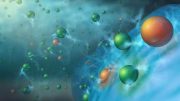

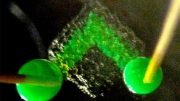
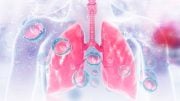
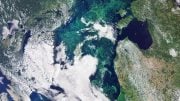


Be the first to comment on "Toxic Legacies: The Lasting Threat of Historic DDT Dumping off Los Angeles Coast"